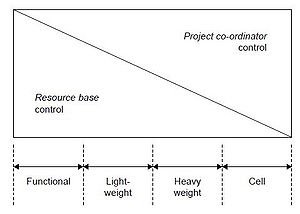Designing Effective Project Organisations
(→The implementation of the project management concept) |
(→The implementation of the project management concept) |
||
| Line 14: | Line 14: | ||
Winch has presented three different actors within construction management; The client, the project manager and the resource-bases. The resource bases provide skills required to execute different task within the project. Paul Gaddis has characterised the project manager as the 'manager in the middle', in this context it is between the client and the resource bases. | Winch has presented three different actors within construction management; The client, the project manager and the resource-bases. The resource bases provide skills required to execute different task within the project. Paul Gaddis has characterised the project manager as the 'manager in the middle', in this context it is between the client and the resource bases. | ||
| − | The purpose of the project manager is to act as an interface between the client's desires and the capabilities of the resource bases. In addition the project manager has the responsibility to coordinate during the project life cycle in order to fulfil the client's desires and goals. Across different industries an extensive review of research regarding the application of the project management concept has identified a range of applications, which is presented in figure | + | The purpose of the project manager is to act as an interface between the client's desires and the capabilities of the resource bases. In addition the project manager has the responsibility to coordinate during the project life cycle in order to fulfil the client's desires and goals. Across different industries an extensive review of research regarding the application of the project management concept has identified a range of applications, which is presented in figure 1. [[File:PM_CONCEPT.JPG|300px|right|thumb|Figure 1: The implementation of the project management concept.<ref name=Winch <i>Graham M. Winch (2010), "Managing Construction Projects"</ref>]] |
Revision as of 16:38, 19 June 2017
This article will present and discuss the following chapters:
- 15.4 The responsibilities of the client
- 15.5 Who is the project manager?
- 15.6 Organising the project through the life cycle
- 15.7 Project organisation in construction
- 15.8 Determining the organisation breakdown structure
This article will first present the most relevant terms and definitions within the chapters. Afterwards some of the models and theories will be analysed and discussed, in addition literature studies will also be carried out to support the article. Lastly, some recommendations or reflections upon the topics will be conducted.
When designing effective project organisations a lot of different factors and actors have to be considered, for instance the responsibilities and management options of the client. How to organise through the life cycle of a project, determination of the organisational breakdown structure and creating optimal and efficient project teams.
Contents |
The implementation of the project management concept
Winch has presented three different actors within construction management; The client, the project manager and the resource-bases. The resource bases provide skills required to execute different task within the project. Paul Gaddis has characterised the project manager as the 'manager in the middle', in this context it is between the client and the resource bases.
The purpose of the project manager is to act as an interface between the client's desires and the capabilities of the resource bases. In addition the project manager has the responsibility to coordinate during the project life cycle in order to fulfil the client's desires and goals. Across different industries an extensive review of research regarding the application of the project management concept has identified a range of applications, which is presented in figure 1.
Winch has presented an overview of the different responsibilities that the project and resource-base managers have, this is illustrated by table XX.
Different managers within construction management
The responsibilities of the client
The client assembles a coalition of firms to execute the project mission, and the contractual documents between the firms define the project organisation structure. However the client possess important responsibilities towards leading the project coalition, the responsibilities are:
- Promoter – defining the need for the project and ensuring that it meets that need;
- Financier – obtaining the capital required to finance the project;
- Decision-maker – making those decisions required to push the project through the life cycle;
- Recruiter – mobilising the most appropriate and capable firms to realise the project. This is a legal obligation under European health and safety legislation.
It is difficult to fulfil all the responsibilities and usually not all the clients have the proper organisational capabilities. The need for these organisational capabilities has led to a development of firms who provide project management services. These firms are often called 'project managers', but in practice, they do not manage and provide co-ordination between resource bases, instead they help the client fulfil its responsibilities towards the project coalition. Winch has presented some of the client's project management options, this is illustrated on figure XX. [2]